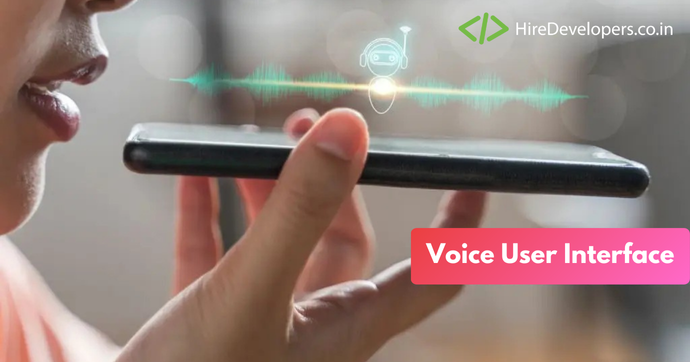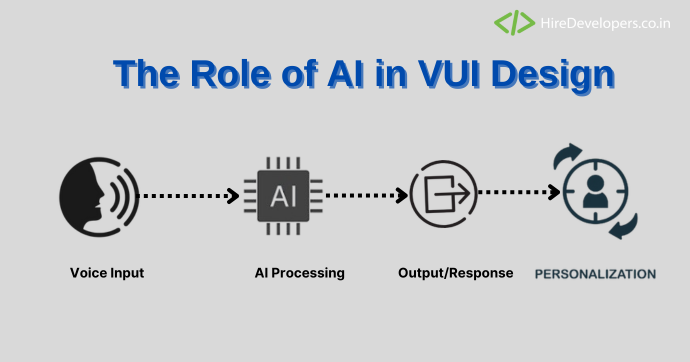December 1, 2024
How AI is Transforming Voice User Interface (VUI) Design?: Key Benefits, Real-World Examples

Artificial Intelligence (AI) One of the most remarkable changes is in voice user interface (VUI) design, which has evolved significantly with AI’s capabilities. Voice User Interfaces (VUI) allow users to interact with devices and applications through spoken commands, making technology more intuitive and easier to access. As AI continues to improve, VUI is becoming smarter, more personalized, and widely adopted across various industries. In this blog, we’ll explore how AI is transforming VUI design, the key benefits of this evolution, and some real-world examples of AI-driven voice interfaces.
What Is Voice User Interface (VUI)?
A Voice User Interface (VUI) enables users to interact with applications and control devices using voice commands. From the early days of speech recognition to today’s AI-powered assistants, VUI has come a long way. Modern VUIs use AI to understand natural language, respond accurately, and learn from user interactions. This technology is used in smartphones, smart speakers, and cars, making it a crucial part of daily life for many people.

The Role of AI in VUI Design
AI is at the heart of modern VUI design. It enables voice interfaces to understand and respond to complex user commands, making interactions more fluid and natural. With AI, VUIs can handle accents, variations in language, and contextual clues, providing a seamless user experience. Machine learning and natural language processing (NLP) are two AI-driven technologies that have significantly improved the accuracy and efficiency of VUIs, enabling them to process large amounts of data and learn from user behavior over time.

Key Benefits of AI-Driven VUI
1. Enhanced User Experience
AI-powered VUIs offer a more natural and intuitive user experience. By understanding context, tone, and language, VUIs can adapt responses to match user needs. This allows for smoother interactions, especially in applications like customer service, where users appreciate quick, accurate responses.
2. Personalization
With AI, VUIs can learn from past interactions and provide personalized responses. This makes users feel valued and understood, as VUI can remember preferences, predict needs, and adjust settings accordingly. For instance, AI-driven VUIs in smart homes can learn user routines and adjust lighting, temperature, and other settings based on their daily patterns.
3. Improved Accessibility
One of the most impactful benefits of AI in VUI is accessibility. For individuals with disabilities, voice-controlled devices can be life-changing. AI-driven VUIs offer a hands-free, easy way to interact with technology, empowering users who may have difficulty using traditional interfaces.
4. Increased Efficiency
AI-based VUIs are also highly efficient in various industries. In businesses, they can automate repetitive tasks, handle customer inquiries, and even schedule appointments, reducing the workload on human employees.
5. Real-Time Language Translation
AI has enabled VUIs to offer real-time language translation, making it easier for people who speak different languages to communicate. For example, travelers can now use their phones to translate conversations with locals, breaking down language barriers instantly.
Real-World Examples of AI in VUI
1. Amazon Alexa and Google Assistant
Amazon Alexa and Google Assistant are leading examples of how AI is transforming VUI design. Both platforms use machine learning and NLP to provide personalized and accurate responses. Alexa and Google Assistant can perform a wide range of tasks, from answering questions to controlling smart home devices. These VUIs continue to evolve with AI overview updates, offering users an increasingly intuitive experience.
2. Apple Siri and Samsung Bixby
Apple’s Siri and Samsung’s Bixby are other examples of AI-driven VUIs that have transformed how people interact with their devices. Siri and Bixby allow users to control their phones, ask questions, and manage tasks hands-free. By learning from user behavior, these VUIs have become more responsive, making everyday interactions faster and more convenient.
3. Healthcare Applications
In healthcare, AI-driven VUIs are used in applications that assist both patients and healthcare professionals. For example, apps like Babylon Health and Ada use VUI to guide patients through symptom-checking and triage processes. AI-driven voice assistants can answer health-related queries, manage appointments, and remind patients to take medications, which enhances patient care and improves efficiency in medical settings.
4. Automotive Voice Assistants
Voice assistants in cars have come a long way, with companies like Tesla, BMW, and Ford incorporating advanced VUIs powered by AI. These assistants allow drivers to control navigation, music, climate and even make calls without taking their hands off the wheel. The use of AI ensures that VUIs in vehicles are responsive, safe, and user-friendly, contributing to a more comfortable and secure driving experience.
5. Customer Service Chatbots
Many companies now use AI-driven VUIs in their customer service departments. Virtual assistants like IBM’s Watson Assistant are used to handle customer inquiries, provide information, and offer support. These VUIs are available 24/7, which helps companies meet customer needs around the clock while reducing wait times and operational costs.
The Future of AI in VUI Design
The integration of AI in VUI design is just the beginning. As AI technologies continue to advance, we can expect VUIs to become even more sophisticated and capable. Future VUIs may incorporate emotional recognition, allowing them to respond based on the user’s emotional state, and making interactions more empathetic. Additionally, advancements in AI could enable VUIs to understand context even better, providing responses that are highly relevant and personalized.
Voice interfaces may also become more proactive in helping users, suggesting information or actions before they’re even requested. For example, a VUI might remind you of an upcoming meeting or suggest weather-related travel adjustments based on your calendar.
Conclusion
Artificial Intelligence is playing a crucial role in the development of Voice User Interfaces, transforming them into intelligent, responsive, and user-friendly tools. With AI-powered VUI design, companies are able to offer better customer service, improve accessibility, and deliver a personalized user experience. From smart speakers to healthcare applications and automotive systems, AI-driven VUIs are becoming an essential part of our lives. As technology continues to evolve, it’s exciting to think about the possibilities that the future holds for VUI.
The integration of AI in VUI design is not only improving the way we interact with technology but is also making it accessible and intuitive for everyone. This is an exciting era for voice technology, and with AI driving innovation, the potential for VUI is limitless.
Must Know-: Integrating AI in React Native Development





